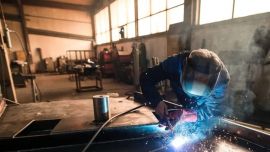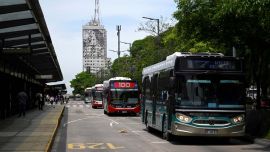More than four weeks on from the femicide of the two Israeli sisters, Pyrhia Saroussy and Lily Pereg, the world continues to be shocked. New details are emerging that could be drawn straight from the script of a horror film.
Forensic results now show that Pyrhia, 63, the mother of the suspected murderer, 37-year-old Nicolás Gil Pereg, was strangled by a rope. Nicolás killed his 54-year-old aunt, Lily, with three bullets to the head.
While the repercussions of this case have been international, with the world’s media watching on, they have been biggest in Mendoza where Gil Pereg, an Israeli Army veteran, is currently detained in San Felipe jail.
It has been decided that his trial will be one of the first to be tried by jury in the province.
Law 9.106, defining trial by jury in the province of Mendoza, was approved last October and signed into law last December. The province’s Justice Secretary Marcelo D’Agostino hails the initiative: “I have every confidence in the ordinary citizen being able to determine the guilt or innocence of a person, as is the judge in charge of the case. We expect the Pereg trial to be speeded through being judged by a jury while at the same time justice is done.”
According to the official, these high expectations are shared by the citizenry. “In recent weeks many people have phoned in at our offices to ask where they should register as jurors in order to take part in the trial,” he poi nted out, indic a t i n g the extent of interest in the case of the two sisters, who were both born in Israel.
For a case to be raised to trial by jury in Mendoza, legislation establishes that it must be a crime of “homicide aggravated by family links,” which under Article 80 of the national Criminal Code carries a life sentence.
The provincial prosecutor is demanding exemplary punishment for Gil Pereg, while presenting overwhelming evidence to prove his guilt in the trial scheduled for between March and June.
In this respect, Andrés Harfuch, the defence attorney for the San Martín Judicial Department and one of the main advocates of this initiative at national level, highlights: “There’s nothing more transparent than trial by jury. The jurors cannot read the dossiers so that the prosecution and defence have to bring their evidence to the trial and explain it. This makes proceedings so transparent that the citizenry hears all the evidence, thus benefitting the resolution of the case.”
OVERWHELMING PROOF
Gil Pereg, 37, is accused of “homicide aggravated by family links” in the case of his Israeli mother and “homicide aggravated by the use of firearms” in the case of his Australian-Israeli aunt, a professor at the University of New England.
The prosecution has some overwhelming evidence in the case against Gil Pereg, who had lived in Mendoza since 2007.
The two bodies were found buried at the back of his home in Julio Argentino Roca street facing the Guaymallén municipal cemetery. Traces of the blood of the victims were found on the clothing of the accused, as well as human blood containing the DNA of the victims found in his house by a trained police dog. The accused had filed a request for the whereabouts of the victim to be verified.
Last Monday Claudia Ríos, the lawyer prosecuting the femicides, asked that the accused be remanded in custody where he would wait for his trial to start in prison. The accused’s three defence lawyers asked that his cats might be allowed into his cell so that he could look after them. The prosecution blocked the request.
Fernando Guzzo, representing the provincial attorneygeneral’s office, expects the defence to plead their client was in “a psychotic state or delirium” at the time of the crime. This move awaits the results of the psychological and psychiatric tests carried out last week.
CASE HISTORY
The two women vanished in Mendoza province, after travelling to Argentina for a holiday. They had intended to visit Nicolás during their trip. Within days, an online campaign had been launched, in order to try and track down the missing women.
On Monday, January 14, 2019, Gil Pereg reported to the authorities the disappearance of his mother and aunt, whom he claimed he had last seen on the previous Saturday. Afterwards, he spoke to various media outlets, saying that his relatives had been the victims of some crime. He said that he himself was afraid to leave home because of the rampant insecurity present in his neighbourhood.
“Please publish the photos of my mum and aunt, please help look for them,” he begged in interviews with local media.
Guzzo now sees all this as an attempt to build an alibi. “Against any possible plea of insanity, the fact that the accused did all this makes us think that he was not deranged. There was this mise-en-scène to take our measure, and to try to free himself from all suspicion. He seemed worried but we began to suspect when he approached the press so insistently.”
After the crime was discovered, many outlets have since started divulging information on accused and previous business manoeuvres linking the accused to his relatives.
What was the motive for these crimes? Guzzo roundly dismisses this question out of hand: “It’s not worth wasting time and energy spending months going over accounts and analysing businesses. Let’s take these murders to trial and then see what comes out of it all.”
THE CASE
Pyrhia Saroussy and Lily Pereg arrived in Mendoza on Friday, January 11, intending to visit Gil Pereg. They had rented a downtown apartment.
The next morning, as captured by police security cameras, they went out together with Gil Pereg. They caught a bus on Lavalle Street, heading for the house of their son and nephew in Guaymallén, facing the municipal cemetery. After entering, from that moment onward, there is no more footage of the sisters.
Gil Pereg denounced the two disappearances, but in the course of the next few days he gradually became the main suspect. After almost a fortnight of investigation, the bloodstains of the two women were found on his property.
On Friday, January 25, Gil Pereg was arrested and prosecutor Claudia Ríos formally accused him of murdering his relatives.
The next day, the bodies of the two women were found on his property. They were buried two feet deep, covered with stones and pierced by metal rods in the skull, abdomen, vagina and anus.
“In my 29 years in the courts I’ve never seen such a level of brutality,” said Guzzo.
He said the accused “lived like a vagrant” in his home, primarily in a room with no toilet or windows. He slept on a mattress surrounded by cans, rubbish and his cats.
“The stench from Pereg’s room was more nauseating than the bodies of the victims,” Guzzo said grimly.
Trial by jury: in Argentina, as in Hollywood
The defining image of trial by jury has been defined by Hollywood, with hundreds of cases, both fact and fiction, having been played out on the big screen. And, as we all know, trial by jury is used to establish a verdict in cases of serious crimes.
Far from lacking any legal basis in Argentina, trial by jury is to be found in Articles 24, 75 sub-section 12 and 118 of the National Constitution, dating back to 1853.
In Argentina, however, witnessing this kind of trial is fairly recent. Córdoba set the ball rolling in 2004, followed by Neuquén in 2011, Buenos Aires and Chaco in 2015, and Río Negro and Mendoza in 2018.
In the case of Mendoza, Law 9.106 stipulates that everybody appearing on the electoral roll is a potential juror, except for members of the executive, legislative and judicial branches of government and of the Armed Forces, those with a criminal record and those who owe alimony, among other disqualifying criteria.
Members of the jury are chosen by lot and then undergo a rigorous selection process to ensure maximum impartiality.
by BY GASPAR GRIECO


























Comments